Leading the Way to Climate Impact Through Design: Meet Lumen Energy
The time is ripe for clean energy to make an impact—and innovative organizations like Lumen Energy are leading the charge. Focused on making the very complex world of clean energy accessible to commercial real estate owners, Lumen Energy already recognizes the value of design as an early stage company. As Co-Founder Dave Coen explains, “We believe that having really good design is going to be instrumental in making our work possible. Being able to deeply understand our user personas and design elegant ways of presenting really complicated information is mission critical for us.”
We recently sat down (virtually!) with CEO and Co-Founder Peter Light, COO and Co-Founder Dave Coen, Founding Designer Kamini Iyer, and Product Designer Lauren Kim to learn more about what Lumen Energy is working on these days, why designers should consider working in clean tech, and why design will play a critical role in reducing global carbon emissions.
Briefly, what does Lumen Energy do?
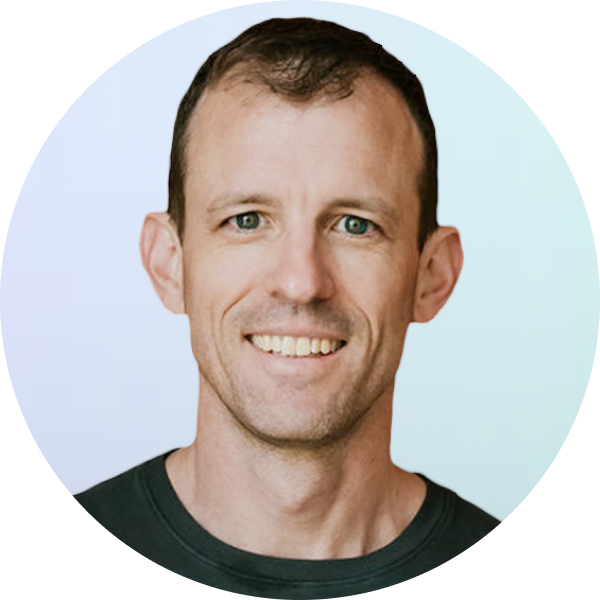 Lumen Energy is the leading clean energy marketplace in the world, and our overall goal is to help every building find the most profitable path to decarbonization.Peter Light, CEO and Co-Founder at Lumen Energy
Lumen Energy is the leading clean energy marketplace in the world, and our overall goal is to help every building find the most profitable path to decarbonization.Peter Light, CEO and Co-Founder at Lumen Energy
Kamini, how does your background in data influence your role and work as a designer?
As a founding designer, my background is a bit unconventional. I began my career as a marketing designer and later transitioned into a role as a data scientist. This unique combination exposed me to two vastly different perspectives: one that focused on the impact of messaging and content on people's behavior, and another that was all about analyzing complex data sets and being able to identify patterns.
At a startup, you end up wearing so many different hats — being able to apply a design eye to all of it has been so great! It’s made it that much easier to step in and uplift the team in whichever ways were needed. Some days that means I’m looking through code with our engineers to sort out what product design decision we should make. On other days, it’s lending a hand with marketing needs. And on other days, it’s helping our team think through product strategy. It’s really helped create a strong culture of design here at Lumen Energy. – Kamini
Why did you decide to join Lumen Energy as a founding designer?
First and foremost, I was interested in working in climate tech, and Lumen Energy stood out to me as a company that was really rooted in comprehensive and systemic solutions to decarbonization for the built environment. In this space, it’s hard to cut through the noise on what are effective climate tech solutions, and what aren’t. Lumen Energy was one of the few companies that thought about the built environment and energy use within the social, environmental, and policy structures already in place (and we’re constantly learning as things are changing!). My instinct was that Lumen Energy was onto something and could truly think about decarbonization at scale.
I also chose to work with Lumen Energy because they had a great team. I wanted to work with a group of people that I genuinely thought could take good, calculated risks and know how to navigate uncertainty. The team here is optimistic but grounded in reality. We’re not naive. This isn’t our first rodeo, in many respects. We’re aiming for continual and sustainable growth, not hypergrowth. It really felt like a unique time to have high impact at Lumen Energy, and I’m very grateful I had the opportunity to join them as a founding designer.
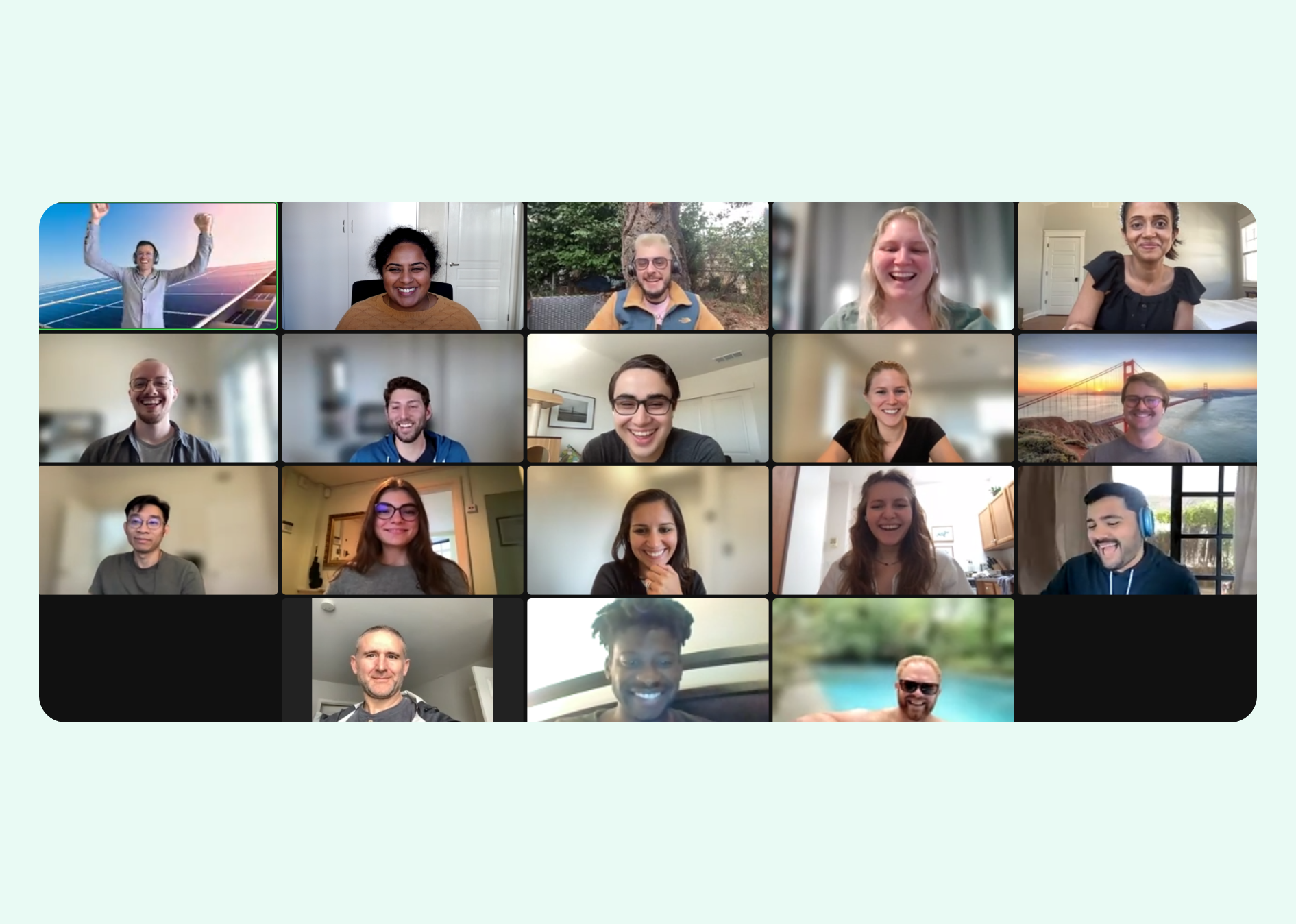
I wanted to work with a group of people that I genuinely thought could take good, calculated risks and know how to navigate uncertainty. The team here is optimistic but grounded in reality.Kamini Iyer
Lumen Energy is also one of the most design-forward companies I’ve ever worked at. Peter and Dave believe design will play an important role in driving a faster transition to a clean energy future. Having a respect for design and its value at such an early stage company is unique—it was unlike any other company I saw in my job search. So a big shoutout to Peter and Dave on that one! – Kamini
 In this space, it’s hard to cut through the noise on what are effective climate tech solutions and what aren’t. Lumen Energy stood out to me as a company that was really rooted in comprehensive and systemic solutions to decarbonization for the built environment.Kamini Iyer, Founding Designer at Lumen Energy
In this space, it’s hard to cut through the noise on what are effective climate tech solutions and what aren’t. Lumen Energy stood out to me as a company that was really rooted in comprehensive and systemic solutions to decarbonization for the built environment.Kamini Iyer, Founding Designer at Lumen Energy
Do you have any advice for folks leading design at an early stage startup?
I have two things I keep top of mind while being a designer at a startup — be flexible & trust your design instincts.
- Being flexible — at a startup, we’re often moving very fast while trying to focus on distilling complex information for our users. We are iterative but also know we can’t get to all of it all at once, so we often are keeping logs of things to come back to in the next iteration as we learn more. I’m also always challenging myself and Lauren to be okay with being comfortable with the uncomfortable, so that might mean our designs aren’t pixel perfect before we move on or we might even detach components (shocker!) and break our design system to make things move faster.
- On trusting your design instincts — it’s so important at a startup. Feedback from users on a new product looks very different (and sometimes doesn’t exist), so you often need to find your own way forward. We try to encourage ourselves toward designs that solve the core problem we’ve identified, and move forward knowing that our work will evolve as we learn more. – Kamini
Peter and Dave, where did your appreciation of design come from?
Great design is expressed in a lot of consumer experiences that we all take for granted today—Airbnb, Uber, Lyft, and Instacart, for example. There’s a lot of complicated stuff going on in the backend of these apps, but you don’t necessarily think about that because they’re so easy to use. For the most part, that quality of design just does not exist in the clean energy space yet. Instead, there’s a lot of enterprise software which is terrible to look at and painful to use. It's like DOS-era stuff.
When founding Lumen Energy, Dave and I had a a precious blank slate to build something new. We thought: let's make the experience feel special and engaging, and encourage people to take a big, unfamiliar step to make a dent in climate change. It should feel enjoyable. – Peter
We’re really excited about the intersection of climate and fintech: how might we use money as a resource to accelerate the change our planet needs? For Lumen Energy, design can be the difference between someone having to make sense of a wall of data versus having a guided experience to help a customer deploy hundreds of millions of dollars towards clean energy—and to do it with confidence. It’s a massive lever for them.Ben Blumenrose, Co-founder and Managing Director, Designer Fund
Why do you think design is so often undervalued in the B2B space?
I think B2B in general has suffered from a misunderstanding of its users. People have been fine with focusing on functionality above all else, but the delight in the experience has been pretty undervalued. Like Peter mentioned, how people interact with everyday consumer products has created a new baseline of expectations for what they should be able to do with enterprise products. Since the industry we’re working in is so new, design can play a huge role in increasing the efficiency and speed at which people are able to process new information and take action. – Kamini
How has design influenced product decisions at Lumen Energy?
Design has been instrumental in helping us distill information for our users. There have been a lot of iterations we’ve gone through on the product and interestingly enough, a lot of that has been informed by what our users don’t know. Essentially, as designers we're trying to figure out how to lay out information, not only for us to understand it better as people who think about this 24 hours a day, but in a way that makes sense to people who only have 5 minutes in a day to engage with our product. It’s definitely an interesting challenge, and we’ve learned a lot just by talking with our users and our experts in-house. – Kamini
We’re also designing for trust and helping our customers get used to a new way of doing things. Watching commercial real estate owner operators, I’m left with how much people still live in email, spreadsheets, and word documents—the everyday document chaos! Managing clean energy projects that scale nationwide across a real estate portfolio is something that is new for people—spreadsheets are very familiar. Some of what we've done with our design is to mimic building off the familiar, but we’re still experimenting with figuring out how else we can build trust in our app experience so that people can transition into a new way of doing things that they may not be comfortable with, but that can ultimately improve the whole process.
Another example: Investors are often working with complex analysis. By designing tools that feel similar to other analytics they’ve done in the past — like sensitivity analysis — we help investors continue doing what they do best: investing! – Peter
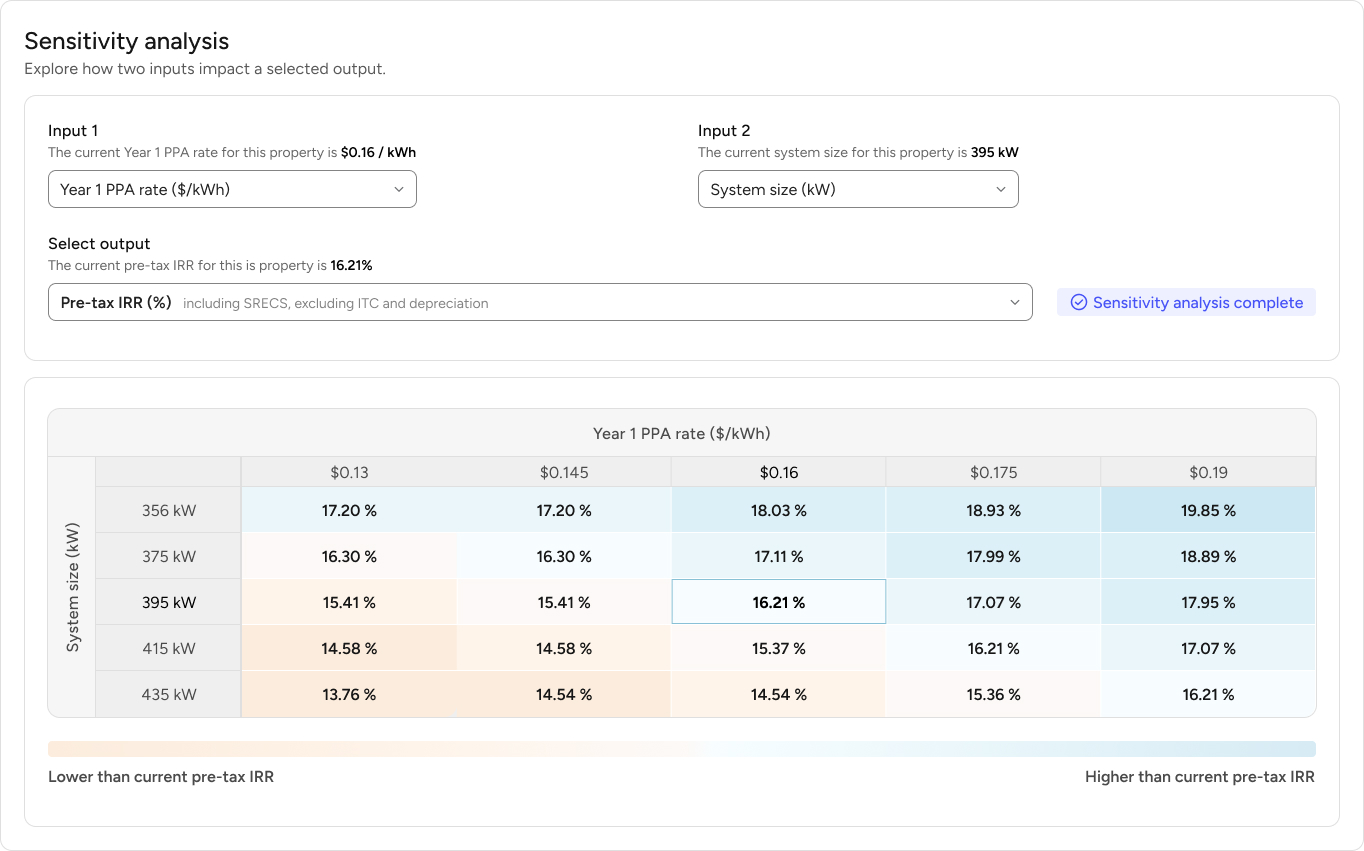
What are some examples of recent projects where design has made a big impact?
With a recent project, our goal was to streamline the bidding and procurement process for clean energy technology deployment. Historically, this process has been through PDF proposals, which are clunky and make it hard to compare offers—if a customer even solicits multiple proposals. Our solution immediately demonstrated impact, as exemplified by a recent project in Georgia: through our app, the building owner received multiple bids, which we analyzed and displayed in easy-to-understand visuals. Our solution helped a customer identify a 53% disparity between the highest and selected bid—without our solution, the customer would have incurred higher costs due to the absence of competitive bidding. By focusing our design efforts on what was once a PDF proposal-driven process, our product was able to enable our construction partners to bid efficiently through a structured bidding process and reduce overall project costs. — Kamini
After hearing from customer feedback, I built on Kamini’s work to create a comparable view of all the bids that could come in for a single project, which makes choosing between construction partners much easier and efficient. — Lauren
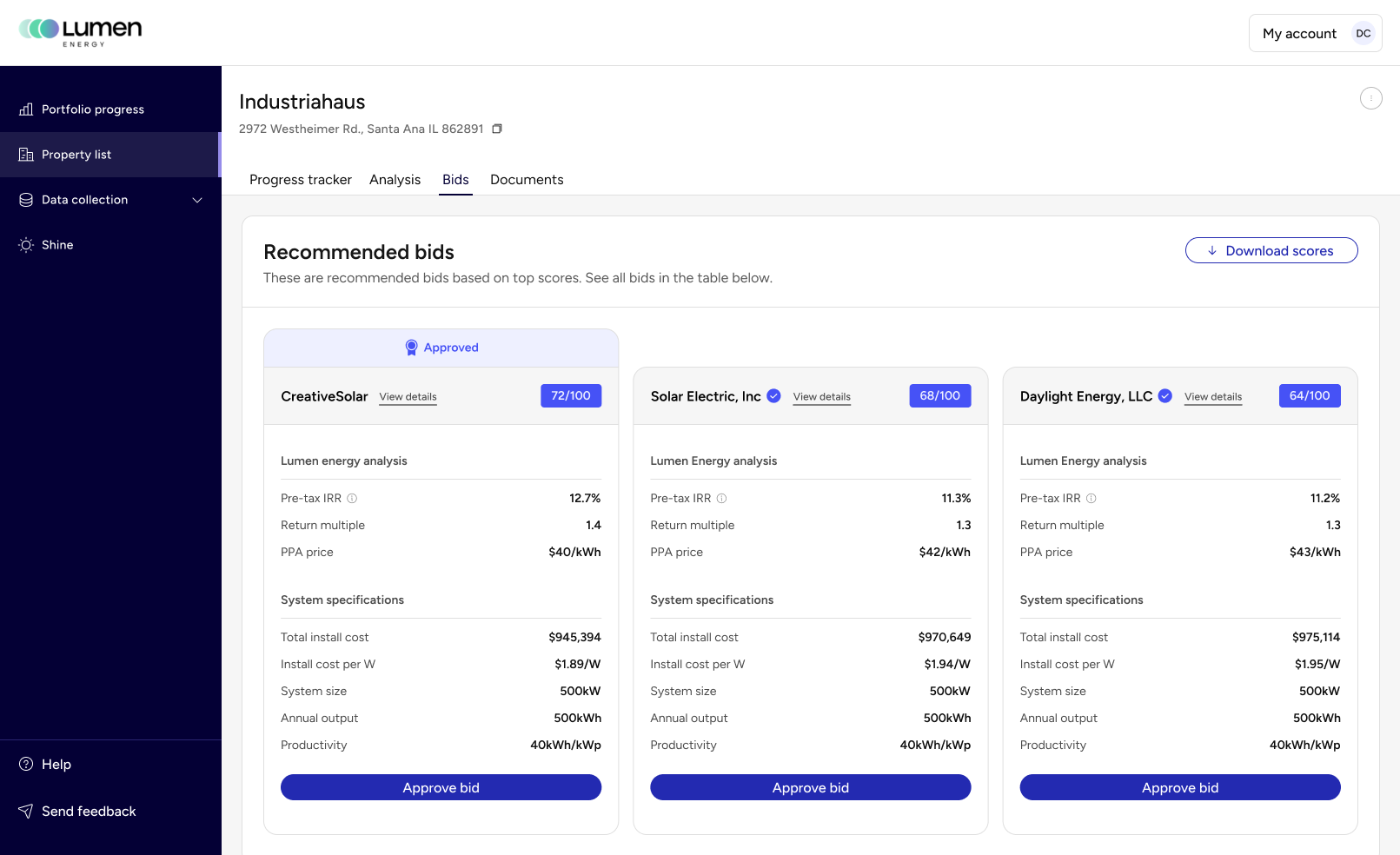
What are some of the big design questions you’re thinking about right now?
One of the big questions we’re grappling with is the ability for users to fulfill multiple roles within our application. If you think about a building owner that wants to install clean energy at their building, there are different ways to approach that: they might make a financial investment in buying a system, they might take out a loan, or they might allow a third party to finance putting clean energy production at their building. Thinking through how the app is going to change and how the user’s perspective on the benefits of clean energy also changes as they transition between those roles is, I think, one of the more complicated design questions that we’re asking right now.
There’s a related challenge there, too, of bringing all of these different parties and personas into the app, sometimes with one very specific task they need to complete. We need to design for the right minimal amount of context to help our users build trust, understand what they’re doing and complete that task without forcing them to spend 10 minutes coming up to speed on something that’s just a 30-second task. So that’s another big challenge for us to explore. – Dave
We’re exploring design on so many levels. There’s design at the visual and UX levels, but we’re thinking through process and collaboration design. For example, when adding solar to a commercial property, there are construction partners, financial partners, decision-makers like CFOs, facility managers, and lawyers who all need to be involved. Essentially, we’re working on a bunch of 0 to 1 problems while also trying to meet the market where it’s at. It’s a massive opportunity to build something completely new from the ground up. – Kamini
Why should designers consider working in climate tech and clean energy these days?
Today, designers have a unique opportunity to join the clean energy industry and learn with it as it grows. Just like the internet had its moment in the 90s and social media platforms kind of had their moment in the 2010s, I think climate tech is having its moment (or is at the very early stages of having its moment) right now. Being able to learn alongside the industry as a designer is one of the most unique ways to educate yourself about a space and contribute to simplifying the process. Designers bring a unique perspective to the table, as we can see patterns and create experiences that help bridge communication gaps as well as provide clearer insights, moving an experience away from jargon and complex processes. There’s just so much potential for impact right now. – Kamini
Now is the ideal time to get into climate tech, because we’re starting to see attractive economics for building owners to decarbonize. The financial incentive is there, but it’s still a really complicated process to go through. We can help change that by creating magical experiences that also enable people to do something good for the world. – Peter
If we don’t do something now, then I don’t know when we would be able to reverse some of the big changes that are happening with our climate issues. – Lauren
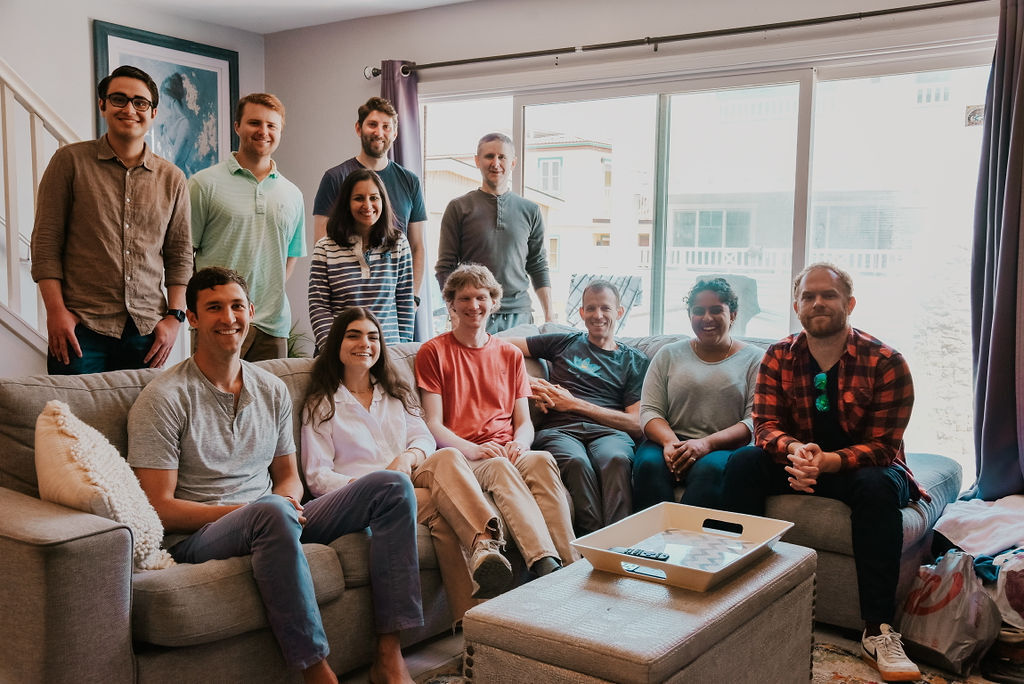
Lauren and Kamini, how much did you know about clean tech before joining Lumen Energy? What was the learning curve like?
I was aware of those big numbers, like, climate catastrophe is X number of years away, but didn’t fully appreciate how complicated it can be to make changes at scale. After being at Lumen Energy, I have a lot of respect for what we’re building. We’re trying to connect a system that’s really not connected at all, and that makes me feel hopeful. – Lauren
I studied some of this while I was in undergrad but there is still so much I need to learn. What’s super cool about this industry is that it’s about our environment, both the built environment and our natural environment. To be able to impact that through technology is a very unique and fascinating opportunity, and we’re lucky to be joining at a time when everything is still so new and ripe for learning on the job. – Kamini
Designers bring a unique perspective to the table, as we can see patterns and create experiences that help bridge communication gaps as well as provide clearer insights, moving an experience away from jargon and complex processes. There’s so much potential for impact right now.Kamini Iyer, Founding Designer at Lumen Energy
Dave, how do you ensure that design has a seat at the table?
One thing that we’ve been intentional about is being very slow to hire product managers. We don’t have any yet. There are downsides to that, but the upsides are that it means that both designers and engineers need to bring a tremendous amount of ownership to the table. It requires us to really clarify the challenges our customers face, which means that our designers are often the ones that own the overall shape of the solution. It’s created this somewhat unique culture in which everyone on the team is expected to contribute to the product, and to define the things that we might tackle next. And I think that’s a special thing about Lumen Energy. – Dave
 We believe that having really good design is going to be instrumental in making our work possible. Being able to deeply understand our user personas and design elegant ways of presenting really complicated information is mission-critical for us.Dave Coen, COO and Co-founder at Lumen Energy
We believe that having really good design is going to be instrumental in making our work possible. Being able to deeply understand our user personas and design elegant ways of presenting really complicated information is mission-critical for us.Dave Coen, COO and Co-founder at Lumen Energy
What do you want the design org to look like in 5 years?
Lumen Energy is the leading clean energy marketplace in the world, and our overall goal is to help every building find the most profitable path to decarbonization. We’re starting with very large commercial real estate firms, but I think our offering and our customer base are going to grow and expand in really interesting ways. We’ll likely have an increasing number of teams targeting different verticals. I would imagine that, over time, as the team grows, we’ll have increased specialization. But things can change quickly and, in five years, who knows? – Dave
I think as our offerings and customer base grows, we’ll want to build a flexible design organization that focuses on having a team of versatile designers who are well-equipped to collaborate closely with stakeholders across the organization. I would hope we could create a structure that enables us to quickly adapt to changing market and user needs, while maintaining a strong design vision. I know we’re in a challenging space and the problems are hard to solve, but it’s actually really exciting! There’s so much for us to learn and build literally from the ground up, while also chipping away at some of the world’s climate issues. Make sure to check out our careers page if that sounds interesting! – Kamini
Sign up for our mailing list to hear about openings at Lumen Energy and other Designer Fund companies.
How does the Designer Fund community support your work?
The Designer Fund community has been something that has made our design team feel much larger than it actually is. I’ve had random questions that I’ll post to the community, and the number of people that engage and respond to me makes it feel less like I have to figure all of this out by myself. It feels a lot less lonely to have a wider network to tap into—being a small team of two, you need that sometimes. – Kamini


